I mentioned a few days ago that the worst move the Pittsburgh Penguins could make at the 2019 Trade Deadline would be dealing for Alex Chiasson of the Edmonton Oilers. It appears Penguins general manager Jim Rutherford saw that and decided to blindside everybody with a jaw-dropping trade.
The Penguins sent Tanner Pearson to the Vancouver Canucks for defenseman Erik Gudbranson just as the deadline struck. Getting rid of Pearson in itself isn’t bad — he had been reduced to a fourth-line role and was going to count for $3.75 million on the Penguins’ cap for two more seasons — but acquiring Gudbranson makes no sense.
Related: Canucks’ Gudbranson Trade a Massive Win
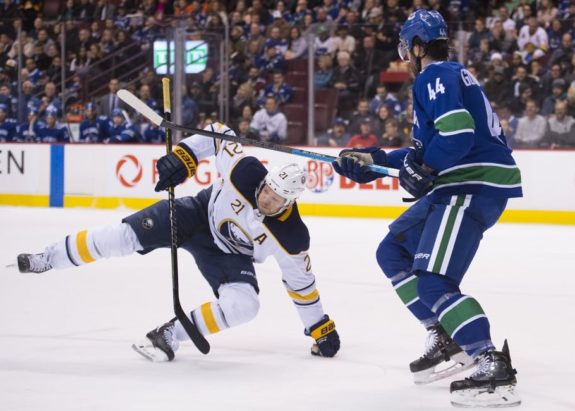
Even with the injuries suffered by Kris Letang and Brian Dumoulin during Saturday night’s Stadium Series game against the Philadelphia Flyers not believed to be long-term, it’s not shocking the Penguins made some moves on the blue line. Everybody expected the worst-case scenario to be Cody Ceci of the Ottawa Senators, but Rutherford managed to outdo everybody’s worst fears by acquiring Gudbranson.
It’s another backward move for a team that’s made a number of them over the past two seasons, and it’s going to have an impact on the remainder of the Penguins’ championship window.
Subtraction by Addition
Gudbranson is among the worst defensemen in the NHL and has been for a long time. It’s a head-scratching move. It wasn’t needed. He will account for $4 million against the Penguins’ cap for two more seasons. So they add an inferior player and take on an extra $250,000 to do so. For a team that’s consistently up against the cap ceiling, it’s mind-blowing even to consider this trade.
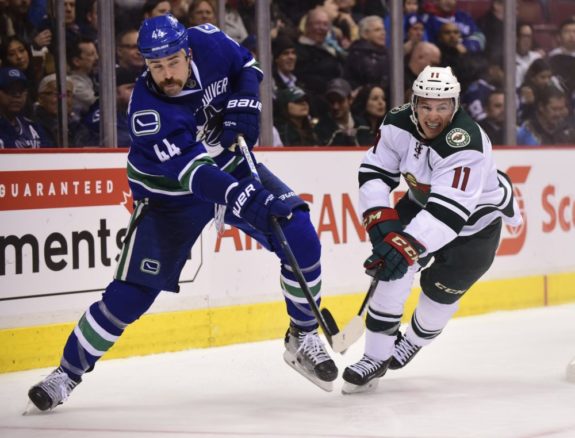
Gudbranson has consistently been one of the worst possession players in the league, and he’s been even worse this season despite the Canucks being a better team overall. For the Penguins, who need to acquire depth players with good possession numbers, it’s foolish.
Here’s how Gudbranson ranks among defensemen who’ve played at least 500 minutes at five-on-five this season in Corsi for percentage (CF%), Fenwick for percentage (FF), shots for percentage (SF%), scoring chances for percentage (SCF%) and goals for percentage (GF%):
- CF%: 43.5 (sixth-last)
- FF%: 43.6 (seventh-last)
- SF%: 43.3 (seventh-last)
- SCF%: 38.6 (last)
- GF%: 34.4 (third-last)
Those are bad. Also, it doesn’t get any better if you look at how he stands in those categories among defenders who’ve played 1,500 minutes at five-on-five since the 2016-17 season.
- CF%: 44.6 (second-last)
- FF%: 44.1 (second-last)
- SF%: 44.2 (last)
- SCF%: 41.4 (last)
- GF%: 36.7 (last)
Those numbers create the argument that he is the worst defenseman in the league and the Penguins have committed to him for the next two seasons, at least. It’s not just a product of playing for a generally bad team either, even his Goals Above Replacement number ranked him as the least valuable defender on the Canucks.
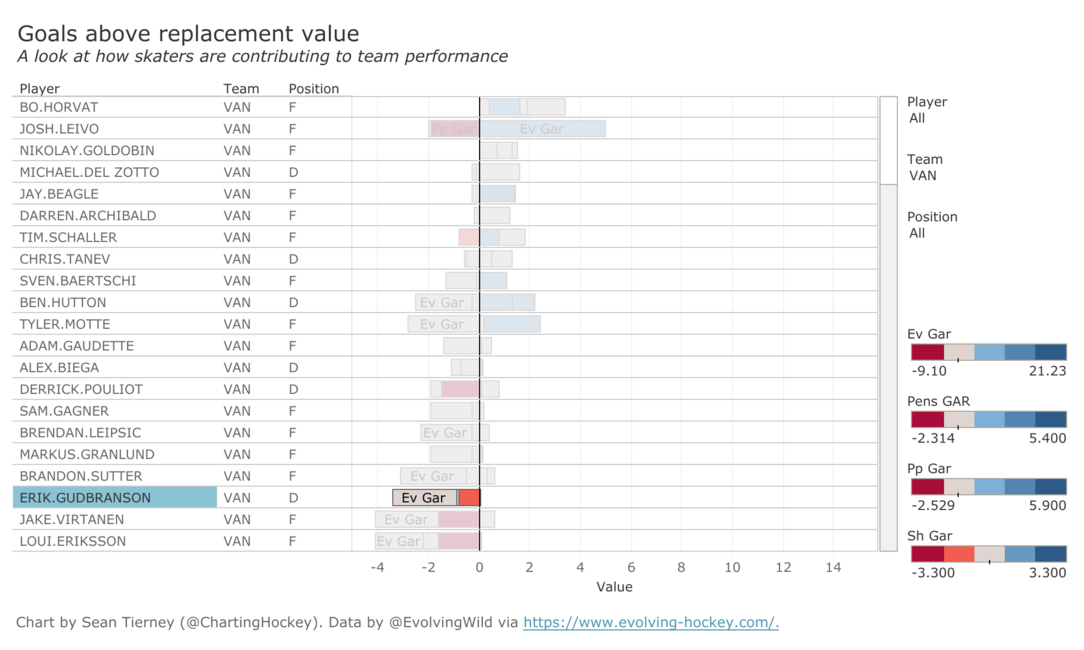
For those who don’t put stock into analytics, the eye test with Gudbranson isn’t pretty either.
He can’t skate, which is an issue when the Penguins’ blue line already features Jack Johnson and Olli Maatta. His first pass isn’t good at all, and it’s going to lead to the Penguins’ forwards getting stuck in the neutral zone trying to retrieve it. He can’t make a defensive read, and defensive zone lapses are already something the Penguins make plenty of already.
Maybe if he were a rookie or had just 50 games under his belt, there’d be more reason to be optimistic, but it’s not like he’s going to turn his entire philosophy around after 448 career games. Gudbranson is what he is, and it’s not good.
Also, no, just because the Penguins managed to turn Justin Schultz’s career around doesn’t mean Gudbranson is going to do the same. Schultz was never bad. He just had his confidence shot playing for the most incompetent franchise in the league. Once he was released from the shackles of the Oilers organization and found a team willing to give him a chance, his career took off. Gudbranson, on the other hand, has tons of data and game tape to show that nothing is going to change.
In a truly unexpected and unneeded development, the hotly talked about Johnson isn’t even the worst defensemen on the Penguins anymore. That’s how bad Gudbranson has been throughout his career. The Penguins now have $7.25 million of cap space tied up into Johnson and Gudbranson, two sub-replacement level defensemen, through the 2020-21 season.
That’s $7.25 million that could’ve been used to target two legitimate top-four pieces and stabilize the defense corps for the foreseeable future. It’s a move of sheer incompetence. As a team that’s supposed to be in win-now mode, they’ve acquired a combination even a team deliberately tanking for a high draft pick wouldn’t think about putting together.
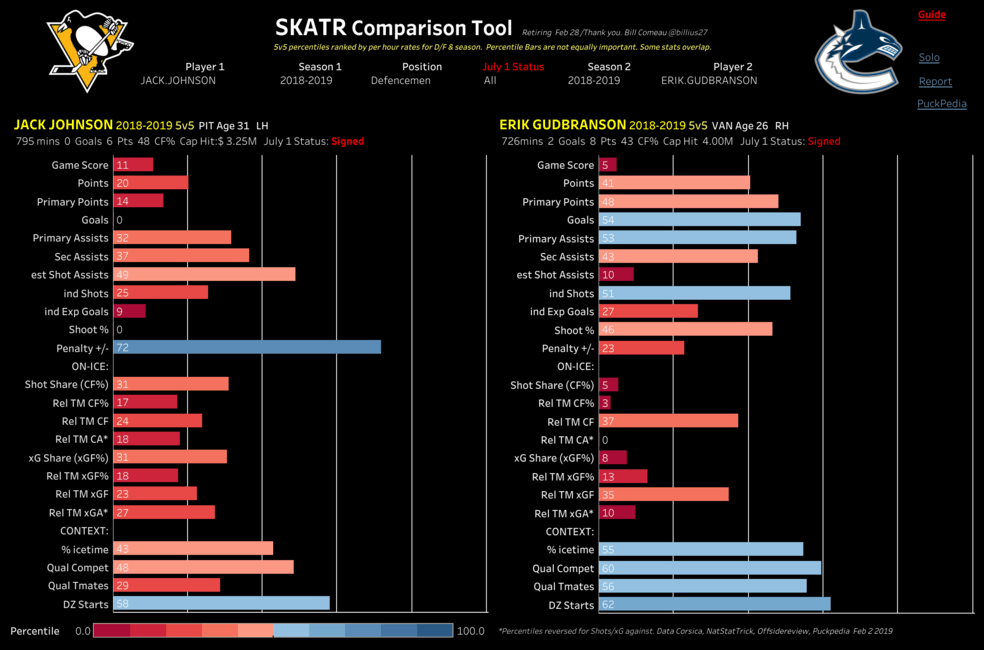
There’s an offensive combination like Sidney Crosby and Evgeni Malkin, and then there’s a straight-up offensive combination of two of the worst defensemen in the league. It’s voluntarily handicapping a roster that needs every break it can get as they sit a point outside of a playoff spot with 20 games remaining in the 2018-19 season.
Gudbranson’s arrival is almost certainly going to push Marcus Pettersson out of the lineup when everybody is healthy. It’s the wrong move, but the Penguins didn’t acquire a guy making $4 million a season to sit in the press box.
When all six defensemen are healthy the Penguins’ lineup will likely look like this:
Letang-Dumoulin
Schultz-Maatta
Gudbranson-Johnson
Extras: Juuso Riikola, Pettersson
The Penguins would be better off if they switched their third pairing with the scratches, but that’s not going to happen. Why? Because the Penguins have committed themselves to two horrible deals and they’re not going to admit they’re wrong no matter how much it hurts their on-ice product.
Enforcers Protecting Stars Is a Myth
Rutherford continues to look for snarl, grit, and toughness when it’s become obsolete in today’s version of the game. In a post-deadline presser, he said the following about Gudbranson.
He’s a real heart and soul guy… He can protect our players. He puts us in a stronger position to push back when we get into more physical games.
Nothing Rutherford said has anything to do with what matters, Gudbranson’s on-ice ability. When the only traits you can list for a player don’t involve their skill level, it’s not a good sign.
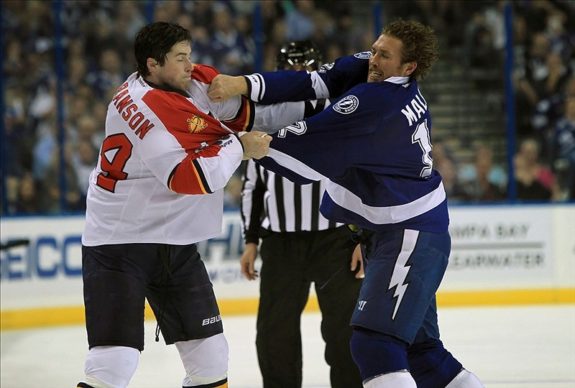
Also, the whole protection thing is a myth. These are NHL players, not children on a playground. Being a big player who can fight isn’t going to deter an opponent from taking liberties on a star player. The Penguins, better than anybody, should know this.
So y’all really think Wayne Simmonds doesn’t make that body check on Dumoulin if Gudbranson is on the bench? Cause I don’t see how anyone is selling me on that.
— Jesse Marshall (@jmarshfof) February 25, 2019
Mike Rupp, Max Talbot, Aaron Asham and Matt Cooke were all in the lineup for the 2011 Winter Classic against the Washington Capitals. That didn’t stop David Steckel from blindsiding Crosby and concussing him. Four days later, everybody except Asham was in the lineup against the Tampa Bay Lightning when Crosby was concussed again following a hit from behind by Victor Hedman. The result? Zero deterrence, zero fights and two concussions for Crosby that led to almost 11 months of missed action.
Crosby isn’t the only Penguins star to not be helped by enforcers in the lineup. When Letang was concussed following a blindside hit by Max Pacioretty in a game against the Montreal Canadiens in Nov. 2011, Cooke and Asham were once again in the lineup. No protection happened, and Letang missed nearly two months of action.
In a game against the Flyers in Jan. 2015, the Penguins had Steve Downie, Robert Bortuzzo and Bobby Farnham in the lineup, and that didn’t stop Zac Rinaldo from boarding Letang from behind and knocking him out of the game. And just two months later, Letang’s season was ended when Shane Doan of the Arizona Coyotes interfered with him and concussed him. Downie fought Doan shortly after, but it didn’t retroactively heal Letang.
Now for an example of Gudbranson’s presence not stopping an injury. When his Canucks teammate, and rookie phenom, Elias Pettersson was choke-slammed to the ice by Florida Panthers defenseman Mike Matheson earlier this season, nobody, including Gudbranson, stood up for him. Pettersson proceeded to miss the next six games with a concussion.
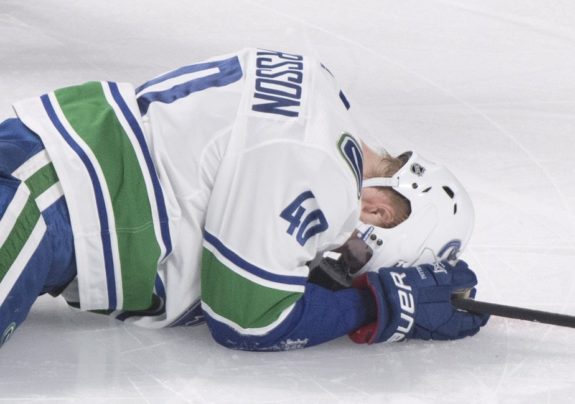
The Penguins aren’t the only team guilty of the enforcer deterrence myth. If you look around the league, almost every team has at least one on their roster, but the Penguins have nearly a decade of experience of enforcers not working at all.
All any deterrence does is put the Penguins down to five defensemen for at least five minutes if Gudbranson drops the gloves. It doesn’t protect or heal the stars, and it doesn’t put any fear into the hearts of opponents. It just adds a fight to his record and five penalty minutes to his season total.
Another Bad Move for an Inconsistent General Manager
Since winning the second of back-to-back Stanley Cups in 2017, Rutherford has shifted entirely away from the philosophy that got him there in the first place: speed and skill.
It started when he traded a first-round pick and Oskar Sundqvist to the St. Louis Blues for Reaves and a second-round pick at the 2017 NHL Draft. It continued just over a week later after free agency opened when he signed Matt Hunwick to a three-year, $6.75 million contract and goalie Antti Niemi to a one-year, $700,000 contract.
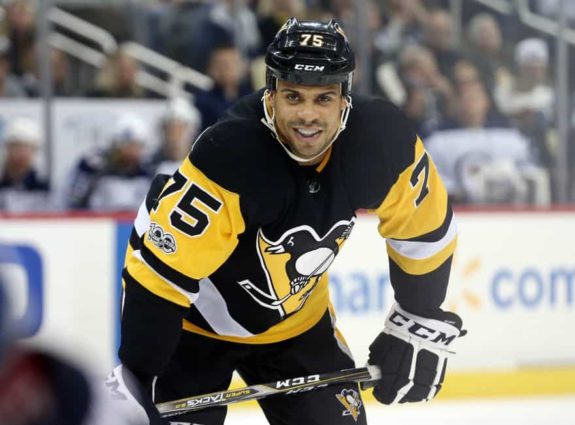
Niemi was waived after allowing 13 goals in three starts. Reaves didn’t make much of an impact and was traded to the Vegas Golden Knights in a three-way trade that brought Derick Brassard to Pittsburgh. The Penguins then extended Patric Hornqvist for five years at $5.3 million per season, and depending who you ask, it was a necessary move to keep the core together or it’ll cripple the Penguins’ cap as the 32-year-old begins to decline.
As for Hunwick, he struggled with injuries and poor play all season and was traded to the Buffalo Sabres, along with Conor Sheary, in June 2018 for a fourth-round pick to clear cap space that Rutherford used to make another mistake a few days later.
The 2018 offseason wasn’t much better for the Penguins. They seemed hellbent on signing Johnson and gave him a five-year, $16.25 million contract. Then Riley Sheahan signed a one-year, $2.1 million deal that, paired with the Johnson signing, wiped out any extra cap the Penguins had to make an impact move.
Rutherford then spent the first few months of the season trying to fix a team that was broken mostly from his doing. He traded Carl Hagelin to the Los Angeles Kings for Pearson, which has essentially become Hagelin for Gudbranson with yesterday’s trade.
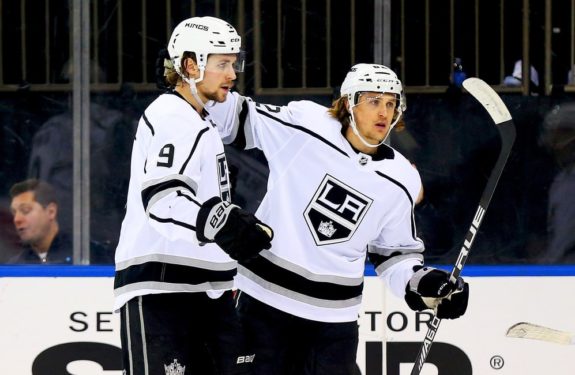
The Penguins then moved former top prospect Daniel Sprong to the Anaheim Ducks for Pettersson in December. That trade has been a rare win for the Penguins, though. Despite Pettersson’s play dropping off in recent weeks, Sprong has become a healthy scratch in Anaheim even with the man who traded for him, Bob Murray, now behind the Ducks’ bench.
Things remained quiet for over a month until the Penguins traded Jamie Oleksiak back to the Dallas Stars for a fourth-round pick. The 26-year-old Oleksiak should’ve been playing for the Penguins every night, but fell out of favor after suffering a concussion in a fight with Tom Wilson of the Capitals back on Dec. 19. Moving Oleksiak back to the Stars looks even worse now with the injuries to Letang, Dumoulin and Maatta.
Then came the reversal of the Brassard trade on Feb. 1 that sent he, Sheahan, a second-round pick and two fourths to the Panthers in exchange for Nick Bjugstad and Jared McCann. So far, the trade is looking like a win for the Penguins in the long-term, but they need McCann and Bjugstad to start being productive right now as they head toward a stretch run.
Related: Penguins 2018-19 Trades — How’d They Do?
Moves like the ones Rutherford is making now are the same ones that ended up getting Ray Shero fired after he couldn’t get the Penguins back into the Stanley Cup conversation following the 2009 victory. Like Shero, Rutherford is on his way to being done in by bad contracts, poor drafting and trades to patch up problems he created himself. The only reason Shero was able to get away with it for so long was that Malkin and Crosby were in their early and mid-20s, not the twilight years of their careers.
It also seems like Rutherford has no set direction that he wants to go in. He has two of the most skilled players of all-time in Crosby and Malkin but appears determined to add big, slow and bad players who will torpedo any chance the Penguins have at securing a fourth Stanley Cup title in their era before a rebuild begins within the next half-decade.
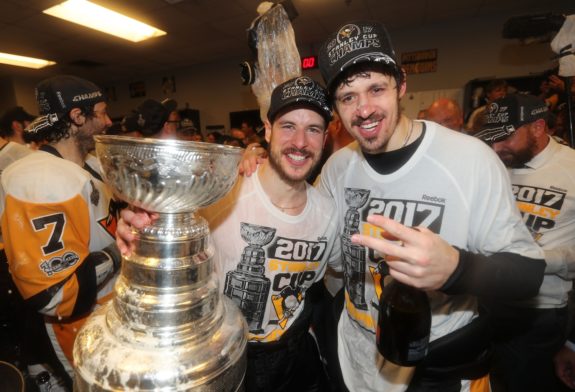
To be fair to Rutherford, he has corrected a fair amount of his mistakes over his tenure as general manager. However, at the same time, needing to fix his errors over the last two years consistently is partially why the Penguins are at the point of being on the playoff bubble. The Penguins’ talent is undeniable, but they’re among the most inconsistent teams in the league and the additions to the roster over the last two years hasn’t allowed their on-ice play to have much room for improvement.
There are questions about if this deal was made to get tougher for when the Penguins play the Capitals again so they can deal with Wilson. If true, this would be a silly reason. The Penguins and Capitals don’t play again this season, neither of them is even a lock to be in the playoffs let alone face each other, plus the fact the Penguins are at their best against the Capitals when they don’t have an enforcer on their roster.
Overall, it was just a confusing and regressive day for the Penguins. They would’ve been better off recalling Zach Trotman, which they did anyway, from the Wilkes-Barre/Scranton Penguins of the AHL on a full-time basis if this was on their mind all along. They were a better team at 11 a.m. on deadline day than they were after the 3:00 p.m. “drop your pencils” buzzer.